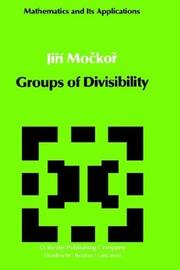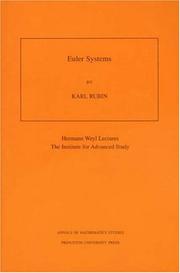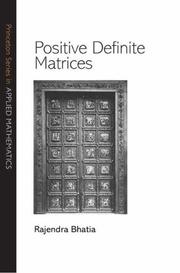| Listing 1 - 10 of 11 | << page >> |
Sort by
|
Book
Year: 1957 Publisher: Belo Horizonte,
Abstract | Keywords | Export | Availability | Bookmark
 Loading...
Loading...Choose an application
- Reference Manager
- EndNote
- RefWorks (Direct export to RefWorks)

ISBN: 9027715394 Year: 1983 Publisher: Dordrecht Reidel
Abstract | Keywords | Export | Availability | Bookmark
 Loading...
Loading...Choose an application
- Reference Manager
- EndNote
- RefWorks (Direct export to RefWorks)
Book
ISBN: 0691221596 Year: 2000 Publisher: Princeton, N.J. : Princeton University Press,
Abstract | Keywords | Export | Availability | Bookmark
 Loading...
Loading...Choose an application
- Reference Manager
- EndNote
- RefWorks (Direct export to RefWorks)
Aristotle's Categories can easily seem to be a statement of a naïve, pre-philosophical ontology, centered around ordinary items. Wolfgang-Rainer Mann argues that the treatise, in fact, presents a revolutionary metaphysical picture, one Aristotle arrives at by (implicitly) criticizing Plato and Plato's strange counterparts, the "Late-Learners" of the Sophist. As Mann shows, the Categories reflects Aristotle's discovery that ordinary items are things (objects with properties). Put most starkly, Mann contends that there were no things before Aristotle. The author's argument consists of two main elements. First, a careful investigation of Plato which aims to make sense of the odd-sounding suggestion that things do not show up as things in his ontology. Secondly, an exposition of the theoretical apparatus Aristotle introduces in the Categories--an exposition which shows how Plato's and the Late-Learners' metaphysical pictures cannot help but seem inadequate in light of that apparatus. In doing so, Mann reveals that Aristotle's conception of things--now so engrained in Western thought as to seem a natural expression of common sense--was really a hard-won philosophical achievement. Clear, subtle, and rigorously argued, The Discovery of Things will reshape our understanding of some of Aristotle's--and Plato's--most basic ideas.
Categorie. --- Aristotele. Categorie. --- Abstract Nouns. --- Academy, The. --- Aspect, verbal. --- Becoming. --- Beings. --- Cave Analogy. --- Clusters. --- Common Sense. --- Count Terms. --- Divisibility. --- Dream Theory, the so-called. --- Elements. --- Entities. --- Essentialism: mereological. --- Expressions. --- Features. --- Genera. --- Heteronymy: generic notion of. --- Homonymy: Aristotle’s notion of. --- Identity (through time). --- Incompleteness. --- Ingredients: Anaxagoras’s conception of. --- Late-Learners, the. --- Linnaean Trees. --- Mass-Terms. --- Mixtures. --- Multiformity: Anaxagorean version of. --- Names. --- Natural Kinds. --- Natures. --- Non-Count Terms. --- Nonsubstance Categories. --- Objects. --- One-Over-Many Principle. --- Ordinary Language. --- Parmenides. --- Paronymy. --- Participation. --- Platonic Forms. --- Predicate Nouns. --- Qualified Things. --- Qualities. --- Receptacle, The. --- Replacement, versus Change. --- Self-Predication (SP). --- Sortal Terms. --- Stuffs and Quasi-Stuffs. --- Tests, Linguistic. --- Things. --- Uniformity: Anaxagorean version of. --- Unity: genuine. --- Whole(s).

ISBN: 0691050759 1400865204 9781400865208 0691050767 9780691050768 9780691050751 9780691050768 Year: 2000 Publisher: Princeton : Princeton University Press,
Abstract | Keywords | Export | Availability | Bookmark
 Loading...
Loading...Choose an application
- Reference Manager
- EndNote
- RefWorks (Direct export to RefWorks)
One of the most exciting new subjects in Algebraic Number Theory and Arithmetic Algebraic Geometry is the theory of Euler systems. Euler systems are special collections of cohomology classes attached to p-adic Galois representations. Introduced by Victor Kolyvagin in the late 1980's in order to bound Selmer groups attached to p-adic representations, Euler systems have since been used to solve several key problems. These include certain cases of the Birch and Swinnerton-Dyer Conjecture and the Main Conjecture of Iwasawa Theory. Because Selmer groups play a central role in Arithmetic Algebraic Geometry, Euler systems should be a powerful tool in the future development of the field. Here, in the first book to appear on the subject, Karl Rubin presents a self-contained development of the theory of Euler systems. Rubin first reviews and develops the necessary facts from Galois cohomology. He then introduces Euler systems, states the main theorems, and develops examples and applications. The remainder of the book is devoted to the proofs of the main theorems as well as some further speculations. The book assumes a solid background in algebraic Number Theory, and is suitable as an advanced graduate text. As a research monograph it will also prove useful to number theorists and researchers in Arithmetic Algebraic Geometry.
Algebraic number theory. --- p-adic numbers. --- Numbers, p-adic --- Number theory --- p-adic analysis --- Galois cohomology --- Cohomologie galoisienne. --- Algebraic number theory --- p-adic numbers --- Abelian extension. --- Abelian variety. --- Absolute Galois group. --- Algebraic closure. --- Barry Mazur. --- Big O notation. --- Birch and Swinnerton-Dyer conjecture. --- Cardinality. --- Class field theory. --- Coefficient. --- Cohomology. --- Complex multiplication. --- Conjecture. --- Corollary. --- Cyclotomic field. --- Dimension (vector space). --- Divisibility rule. --- Eigenvalues and eigenvectors. --- Elliptic curve. --- Error term. --- Euler product. --- Euler system. --- Exact sequence. --- Existential quantification. --- Field of fractions. --- Finite set. --- Functional equation. --- Galois cohomology. --- Galois group. --- Galois module. --- Gauss sum. --- Global field. --- Heegner point. --- Ideal class group. --- Integer. --- Inverse limit. --- Inverse system. --- Karl Rubin. --- Local field. --- Mathematical induction. --- Maximal ideal. --- Modular curve. --- Modular elliptic curve. --- Natural number. --- Orthogonality. --- P-adic number. --- Pairing. --- Principal ideal. --- R-factor (crystallography). --- Ralph Greenberg. --- Remainder. --- Residue field. --- Ring of integers. --- Scientific notation. --- Selmer group. --- Subgroup. --- Tate module. --- Taylor series. --- Tensor product. --- Theorem. --- Upper and lower bounds. --- Victor Kolyvagin. --- Courbes elliptiques --- Nombres, Théorie des
Book
ISBN: 3030658244 3030658236 Year: 2021 Publisher: Cham : Springer International Publishing : Imprint: Springer,
Abstract | Keywords | Export | Availability | Bookmark
 Loading...
Loading...Choose an application
- Reference Manager
- EndNote
- RefWorks (Direct export to RefWorks)
This open access book examines the many contributions of Paul Lorenzen, an outstanding philosopher from the latter half of the 20th century. It features papers focused on integrating Lorenzen's original approach into the history of logic and mathematics. The papers also explore how practitioners can implement Lorenzen’s systematical ideas in today’s debates on proof-theoretic semantics, databank management, and stochastics. Coverage details key contributions of Lorenzen to constructive mathematics, Lorenzen’s work on lattice-groups and divisibility theory, and modern set theory and Lorenzen’s critique of actual infinity. The contributors also look at the main problem of Grundlagenforschung and Lorenzen’s consistency proof and Hilbert’s larger program. In addition, the papers offer a constructive examination of a Russell-style Ramified Type Theory and a way out of the circularity puzzle within the operative justification of logic and mathematics. Paul Lorenzen's name is associated with the Erlangen School of Methodical Constructivism, of which the approach in linguistic philosophy and philosophy of science determined philosophical discussions especially in Germany in the 1960s and 1970s. This volume features 10 papers from a meeting that took place at the University of Konstanz.
Philosophy of mathematics --- History of mathematics --- Mathematical foundations --- Lorenzen on Constructive Mathematics --- Application to Constructive Measure Theory --- Lorenzeṇ’s Work on Lattice-groups and Divisibility Theory --- Krull’s Fundamentalsatz for Integral Domains --- Modern Set Theory and Lorenzen’s Critique of Actual Infinity --- Grundlagenforschung --- Lorenzen’s Consistency Proof and Hilbert’s Larger Programme --- Lorenzen's Dialogue Game --- Game Semantics for Substructural Logics --- Constructive Examination of a Russell-style Ramified Type Theory --- Operative Justification of Logic and Mathematics --- Lorenzen on Proof-theoretic Semantics --- Lorenzen on Databank Management --- Lorenzen on Stochastics --- Russell-style Ramified Type Theory --- Lorenzen and Erlangen School of Methodical Constructivism --- Mathematics --- Mathematics. --- History. --- Mathematical logic. --- Philosophy of Mathematics. --- History of Mathematical Sciences. --- Mathematical Logic and Foundations. --- Philosophy. --- Algebra of logic --- Logic, Universal --- Mathematical logic --- Symbolic and mathematical logic --- Symbolic logic --- Algebra, Abstract --- Metamathematics --- Set theory --- Syllogism --- Math --- Science --- Logic of mathematics --- Mathematics, Logic of

ISBN: 0691089310 1400814782 Year: 2002 Publisher: Princeton (N.J.) Princeton university press
Abstract | Keywords | Export | Availability | Bookmark
 Loading...
Loading...Choose an application
- Reference Manager
- EndNote
- RefWorks (Direct export to RefWorks)
Why do some civil wars end in successfully implemented peace settlements while others are fought to the finish? Numerous competing theories address this question. Yet not until now has a study combined the historical sweep, empirical richness, and conceptual rigor necessary to put them thoroughly to the test and draw lessons invaluable to students, scholars, and policymakers. Wallter examens conflicts from Greece to Laos, China to Columbia, Bosnia to Rwanda
Politique mondiale --- Conflits de basse intensite --- Guerre civile. --- Addis Ababa agreement (1993). --- Afghanistan. --- American Civil War. --- Angola. --- Arusha accords. --- Baumhoegger, Goswin. --- Boutros-Ghali, Boutros. --- Callaghan, James. --- El Salvador. --- Geneva peace agreement. --- Habyarimana, Juvénal. --- Johnson, Phyllis. --- Karker, Hassame. --- King, Charles. --- Lancaster House negotiations. --- Laos. --- Lebanon. --- Nicaragua. --- Rhodesian Front. --- Tela agreement. --- Touval, Saadia. --- United Nations. --- University of Michigan. --- Victoria Falls Conference. --- Young, Andrew. --- Zambia. --- autonomous regions. --- balance of power. --- cease-fire agreements. --- costs of war. --- credible commitment theory. --- democracy-autocracy scale. --- divisibility of stakes. --- ethics of intervention. --- federalism. --- hegemony. --- hypotheses. --- logit analysis. --- mediation. --- military consolidation. --- monitoring and verification. --- multivariate regression analysis. --- one-party rule. --- parliamentary system. --- partition. --- political pacts. --- power-sharing pacts. --- presidential system. --- proportional representation. --- selection bias probit. --- simulation procedure. --- three-stage process. --- Civil war --- Low-intensity conflicts (Military science) --- World politics
Book
ISBN: 0691082189 1322886407 0691628084 0691648328 1400867312 Year: 1978 Publisher: Princeton : Tokyo : Princeton University Press ; University of Tokyo press,
Abstract | Keywords | Export | Availability | Bookmark
 Loading...
Loading...Choose an application
- Reference Manager
- EndNote
- RefWorks (Direct export to RefWorks)
Written by Arthur Ogus on the basis of notes from Pierre Berthelot's seminar on crystalline cohomology at Princeton University in the spring of 1974, this book constitutes an informal introduction to a significant branch of algebraic geometry. Specifically, it provides the basic tools used in the study of crystalline cohomology of algebraic varieties in positive characteristic.Originally published in 1978.The Princeton Legacy Library uses the latest print-on-demand technology to again make available previously out-of-print books from the distinguished backlist of Princeton University Press. These editions preserve the original texts of these important books while presenting them in durable paperback and hardcover editions. The goal of the Princeton Legacy Library is to vastly increase access to the rich scholarly heritage found in the thousands of books published by Princeton University Press since its founding in 1905.
Algebraic geometry --- Geometry, Algebraic. --- Homology theory. --- Functions, Zeta. --- Zeta functions --- Cohomology theory --- Contrahomology theory --- Algebraic topology --- Geometry --- Abelian category. --- Additive map. --- Adjoint functors. --- Adjunction (field theory). --- Adjunction formula. --- Alexander Grothendieck. --- Algebra homomorphism. --- Artinian. --- Automorphism. --- Axiom. --- Banach space. --- Base change map. --- Base change. --- Betti number. --- Calculation. --- Cartesian product. --- Category of abelian groups. --- Characteristic polynomial. --- Characterization (mathematics). --- Closed immersion. --- Codimension. --- Coefficient. --- Cohomology. --- Cokernel. --- Commutative diagram. --- Commutative property. --- Commutative ring. --- Compact space. --- Corollary. --- Crystalline cohomology. --- De Rham cohomology. --- Degeneracy (mathematics). --- Derived category. --- Diagram (category theory). --- Differential operator. --- Discrete valuation ring. --- Divisibility rule. --- Dual basis. --- Eigenvalues and eigenvectors. --- Endomorphism. --- Epimorphism. --- Equation. --- Equivalence of categories. --- Exact sequence. --- Existential quantification. --- Explicit formula. --- Explicit formulae (L-function). --- Exponential type. --- Exterior algebra. --- Exterior derivative. --- Formal power series. --- Formal scheme. --- Frobenius endomorphism. --- Functor. --- Fundamental theorem. --- Hasse invariant. --- Hodge theory. --- Homotopy. --- Ideal (ring theory). --- Initial and terminal objects. --- Inverse image functor. --- Inverse limit. --- Inverse system. --- K-theory. --- Leray spectral sequence. --- Linear map. --- Linearization. --- Locally constant function. --- Mapping cone (homological algebra). --- Mathematical induction. --- Maximal ideal. --- Module (mathematics). --- Monomial. --- Monotonic function. --- Morphism. --- Natural transformation. --- Newton polygon. --- Noetherian ring. --- Noetherian. --- P-adic number. --- Polynomial. --- Power series. --- Presheaf (category theory). --- Projective module. --- Scientific notation. --- Series (mathematics). --- Sheaf (mathematics). --- Sheaf of modules. --- Special case. --- Spectral sequence. --- Subring. --- Subset. --- Symmetric algebra. --- Theorem. --- Topological space. --- Topology. --- Topos. --- Transitive relation. --- Universal property. --- Zariski topology. --- Geometrie algebrique --- Topologie algebrique --- Varietes algebriques --- Cohomologie

ISBN: 1282129740 9786612129742 1400827787 9781400827787 9781282129740 0691129185 9780691129181 6612129743 Year: 2009 Publisher: Princeton, NJ
Abstract | Keywords | Export | Availability | Bookmark
 Loading...
Loading...Choose an application
- Reference Manager
- EndNote
- RefWorks (Direct export to RefWorks)
This book represents the first synthesis of the considerable body of new research into positive definite matrices. These matrices play the same role in noncommutative analysis as positive real numbers do in classical analysis. They have theoretical and computational uses across a broad spectrum of disciplines, including calculus, electrical engineering, statistics, physics, numerical analysis, quantum information theory, and geometry. Through detailed explanations and an authoritative and inspiring writing style, Rajendra Bhatia carefully develops general techniques that have wide applications in the study of such matrices. Bhatia introduces several key topics in functional analysis, operator theory, harmonic analysis, and differential geometry--all built around the central theme of positive definite matrices. He discusses positive and completely positive linear maps, and presents major theorems with simple and direct proofs. He examines matrix means and their applications, and shows how to use positive definite functions to derive operator inequalities that he and others proved in recent years. He guides the reader through the differential geometry of the manifold of positive definite matrices, and explains recent work on the geometric mean of several matrices. Positive Definite Matrices is an informative and useful reference book for mathematicians and other researchers and practitioners. The numerous exercises and notes at the end of each chapter also make it the ideal textbook for graduate-level courses.
Matrices. --- Algebra, Matrix --- Cracovians (Mathematics) --- Matrix algebra --- Matrixes (Algebra) --- Algebra, Abstract --- Algebra, Universal --- Matrices --- 512.64 --- 512.64 Linear and multilinear algebra. Matrix theory --- Linear and multilinear algebra. Matrix theory --- Addition. --- Analytic continuation. --- Arithmetic mean. --- Banach space. --- Binomial theorem. --- Block matrix. --- Bochner's theorem. --- Calculation. --- Cauchy matrix. --- Cauchy–Schwarz inequality. --- Characteristic polynomial. --- Coefficient. --- Commutative property. --- Compact space. --- Completely positive map. --- Complex number. --- Computation. --- Continuous function. --- Convex combination. --- Convex function. --- Convex set. --- Corollary. --- Density matrix. --- Diagonal matrix. --- Differential geometry. --- Eigenvalues and eigenvectors. --- Equation. --- Equivalence relation. --- Existential quantification. --- Extreme point. --- Fourier transform. --- Functional analysis. --- Fundamental theorem. --- G. H. Hardy. --- Gamma function. --- Geometric mean. --- Geometry. --- Hadamard product (matrices). --- Hahn–Banach theorem. --- Harmonic analysis. --- Hermitian matrix. --- Hilbert space. --- Hyperbolic function. --- Infimum and supremum. --- Infinite divisibility (probability). --- Invertible matrix. --- Lecture. --- Linear algebra. --- Linear map. --- Logarithm. --- Logarithmic mean. --- Mathematics. --- Matrix (mathematics). --- Matrix analysis. --- Matrix unit. --- Metric space. --- Monotonic function. --- Natural number. --- Open set. --- Operator algebra. --- Operator system. --- Orthonormal basis. --- Partial trace. --- Positive definiteness. --- Positive element. --- Positive map. --- Positive semidefinite. --- Positive-definite function. --- Positive-definite matrix. --- Probability measure. --- Probability. --- Projection (linear algebra). --- Quantity. --- Quantum computing. --- Quantum information. --- Quantum statistical mechanics. --- Real number. --- Riccati equation. --- Riemannian geometry. --- Riemannian manifold. --- Riesz representation theorem. --- Right half-plane. --- Schur complement. --- Schur's theorem. --- Scientific notation. --- Self-adjoint operator. --- Sign (mathematics). --- Special case. --- Spectral theorem. --- Square root. --- Standard basis. --- Summation. --- Tensor product. --- Theorem. --- Toeplitz matrix. --- Unit vector. --- Unitary matrix. --- Unitary operator. --- Upper half-plane. --- Variable (mathematics).
Book
ISBN: 128301338X 9786613013385 1400838991 9781400838998 9780691150659 0691150656 9780691150666 0691150664 Year: 2011 Publisher: Princeton, NJ
Abstract | Keywords | Export | Availability | Bookmark
 Loading...
Loading...Choose an application
- Reference Manager
- EndNote
- RefWorks (Direct export to RefWorks)
Weyl group multiple Dirichlet series are generalizations of the Riemann zeta function. Like the Riemann zeta function, they are Dirichlet series with analytic continuation and functional equations, having applications to analytic number theory. By contrast, these Weyl group multiple Dirichlet series may be functions of several complex variables and their groups of functional equations may be arbitrary finite Weyl groups. Furthermore, their coefficients are multiplicative up to roots of unity, generalizing the notion of Euler products. This book proves foundational results about these series and develops their combinatorics. These interesting functions may be described as Whittaker coefficients of Eisenstein series on metaplectic groups, but this characterization doesn't readily lead to an explicit description of the coefficients. The coefficients may be expressed as sums over Kashiwara crystals, which are combinatorial analogs of characters of irreducible representations of Lie groups. For Cartan Type A, there are two distinguished descriptions, and if these are known to be equal, the analytic properties of the Dirichlet series follow. Proving the equality of the two combinatorial definitions of the Weyl group multiple Dirichlet series requires the comparison of two sums of products of Gauss sums over lattice points in polytopes. Through a series of surprising combinatorial reductions, this is accomplished. The book includes expository material about crystals, deformations of the Weyl character formula, and the Yang-Baxter equation.
Dirichlet series. --- Weyl groups. --- Weyl's groups --- Group theory --- Series, Dirichlet --- Series --- BZL pattern. --- Class I. --- Eisenstein series. --- Euler product. --- Gauss sum. --- Gelfand-Tsetlin pattern. --- Kashiwara operator. --- Kashiwara's crystal. --- Knowability Lemma. --- Kostant partition function. --- Riemann zeta function. --- Schur polynomial. --- Schützenberger involution. --- Snake Lemma. --- Statement A. --- Statement B. --- Statement C. --- Statement D. --- Statement E. --- Statement F. --- Statement G. --- Tokuyama's Theorem. --- Weyl character formula. --- Weyl denominator. --- Weyl group multiple Dirichlet series. --- Weyl vector. --- Whittaker coefficient. --- Whittaker function. --- Yang-Baxter equation. --- Yang–Baxter equation. --- accordion. --- adele group. --- affine linear transformation. --- analytic continuation. --- analytic number theory. --- archimedean place. --- basis vector. --- bijection. --- bookkeeping. --- box-circle duality. --- boxing. --- canonical indexings. --- cardinality. --- cartoon. --- circling. --- class. --- combinatorial identity. --- concurrence. --- critical resonance. --- crystal base. --- crystal graph. --- crystal. --- divisibility condition. --- double sum. --- episode. --- equivalence relation. --- f-packet. --- free abelian group. --- functional equation. --- generating function. --- global field. --- ice-type model. --- inclusion-exclusion. --- indexing. --- involution. --- isomorphism. --- knowability. --- maximality. --- nodal signature. --- nonarchimedean local field. --- noncritical resonance. --- nonzero contribution. --- p-adic group. --- p-adic integral. --- p-adic integration. --- partition function. --- polynomial. --- preaccordion. --- prototype. --- reduced root system. --- representation theory. --- residue class field. --- resonance. --- resotope. --- row sums. --- row transfer matrix. --- short pattern. --- six-vertex model. --- snakes. --- statistical mechanics. --- subsignature. --- tableaux. --- type. --- Γ-equivalence class. --- Γ-swap.
Book
ISBN: 1400880564 Year: 2016 Publisher: Princeton, NJ : Princeton University Press,
Abstract | Keywords | Export | Availability | Bookmark
 Loading...
Loading...Choose an application
- Reference Manager
- EndNote
- RefWorks (Direct export to RefWorks)
Elements of Mathematics takes readers on a fascinating tour that begins in elementary mathematics-but, as John Stillwell shows, this subject is not as elementary or straightforward as one might think. Not all topics that are part of today's elementary mathematics were always considered as such, and great mathematical advances and discoveries had to occur in order for certain subjects to become "elementary." Stillwell examines elementary mathematics from a distinctive twenty-first-century viewpoint and describes not only the beauty and scope of the discipline, but also its limits.From Gaussian integers to propositional logic, Stillwell delves into arithmetic, computation, algebra, geometry, calculus, combinatorics, probability, and logic. He discusses how each area ties into more advanced topics to build mathematics as a whole. Through a rich collection of basic principles, vivid examples, and interesting problems, Stillwell demonstrates that elementary mathematics becomes advanced with the intervention of infinity. Infinity has been observed throughout mathematical history, but the recent development of "reverse mathematics" confirms that infinity is essential for proving well-known theorems, and helps to determine the nature, contours, and borders of elementary mathematics.Elements of Mathematics gives readers, from high school students to professional mathematicians, the highlights of elementary mathematics and glimpses of the parts of math beyond its boundaries.
Mathematics --- Math --- Science --- Study and teaching (Higher) --- Abstract algebra. --- Addition. --- Algebra. --- Algebraic equation. --- Algebraic number. --- Algorithm. --- Arbitrarily large. --- Arithmetic. --- Axiom. --- Binomial coefficient. --- Bolzano–Weierstrass theorem. --- Calculation. --- Cantor's diagonal argument. --- Church–Turing thesis. --- Closure (mathematics). --- Coefficient. --- Combination. --- Combinatorics. --- Commutative property. --- Complex number. --- Computable number. --- Computation. --- Constructible number. --- Continuous function (set theory). --- Continuous function. --- Continuum hypothesis. --- Dedekind cut. --- Dirichlet's approximation theorem. --- Divisibility rule. --- Elementary function. --- Elementary mathematics. --- Equation. --- Euclidean division. --- Euclidean geometry. --- Exponentiation. --- Extended Euclidean algorithm. --- Factorization. --- Fibonacci number. --- Floor and ceiling functions. --- Fundamental theorem of algebra. --- Fundamental theorem. --- Gaussian integer. --- Geometric series. --- Geometry. --- Gödel's incompleteness theorems. --- Halting problem. --- Infimum and supremum. --- Integer factorization. --- Integer. --- Least-upper-bound property. --- Line segment. --- Linear algebra. --- Logic. --- Mathematical induction. --- Mathematician. --- Mathematics. --- Method of exhaustion. --- Modular arithmetic. --- Natural number. --- Non-Euclidean geometry. --- Number theory. --- Pascal's triangle. --- Peano axioms. --- Pigeonhole principle. --- Polynomial. --- Predicate logic. --- Prime factor. --- Prime number. --- Probability theory. --- Probability. --- Projective line. --- Pure mathematics. --- Pythagorean theorem. --- Ramsey theory. --- Ramsey's theorem. --- Rational number. --- Real number. --- Real projective line. --- Rectangle. --- Reverse mathematics. --- Robinson arithmetic. --- Scientific notation. --- Series (mathematics). --- Set theory. --- Sign (mathematics). --- Significant figures. --- Special case. --- Sperner's lemma. --- Subset. --- Successor function. --- Summation. --- Symbolic computation. --- Theorem. --- Time complexity. --- Turing machine. --- Variable (mathematics). --- Vector space. --- Word problem (mathematics). --- Word problem for groups. --- Zermelo–Fraenkel set theory.
| Listing 1 - 10 of 11 | << page >> |
Sort by
|

 Search
Search Feedback
Feedback About UniCat
About UniCat  Help
Help News
News